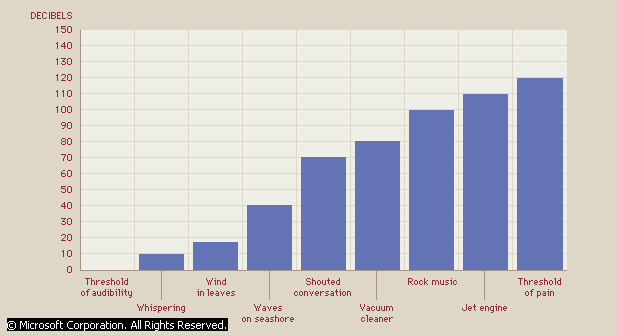Noise Pollution

Click on the picture to see the bigger view of the graph.
Unwanted sound, or noise, such as that produced by airplanes, traffic, or industrial machinery, is considered a form of pollution. Noise pollution is at its worst in densely populated areas. It can cause hearing loss, stress, high blood pressure, sleep loss, distraction, and lost productivity.
Sounds are produced by objects that vibrate at a rate that the ear can detect. This rate is called frequency and is measured in hertz, or vibrations per second. Most humans can hear sounds between 20 and 20,000 hertz, while dogs can hear high-pitched sounds up to 50,000 hertz. While high-frequency sounds tend to be more hazardous and more annoying to hearing than low-frequency sounds, most noise pollution damage is related to the intensity of the sound, or the amount of energy it has. Measured in decibels, noise intensity can range from zero, the quietest sound the human ear can detect, to over 160 decibels. Conversation takes place at around 40 decibels, a subway train is about 80 decibels, and a rock concert is from 80 to 100 decibels. The intensity of a nearby jet taking off is about 110 decibels. The threshold for pain, tissue damage, and potential hearing loss in humans is 120 decibels. Long-lasting, high-intensity sounds are the most damaging to hearing and produce the most stress in humans.
Solutions to noise pollution include adding insulation and sound-proofing to doors, walls, and ceilings; using ear protection, particularly in industrial working areas; planting vegetation to absorb and screen out noise pollution; and zoning urban areas to maintain a separation between residential areas and zones of excessive noise.